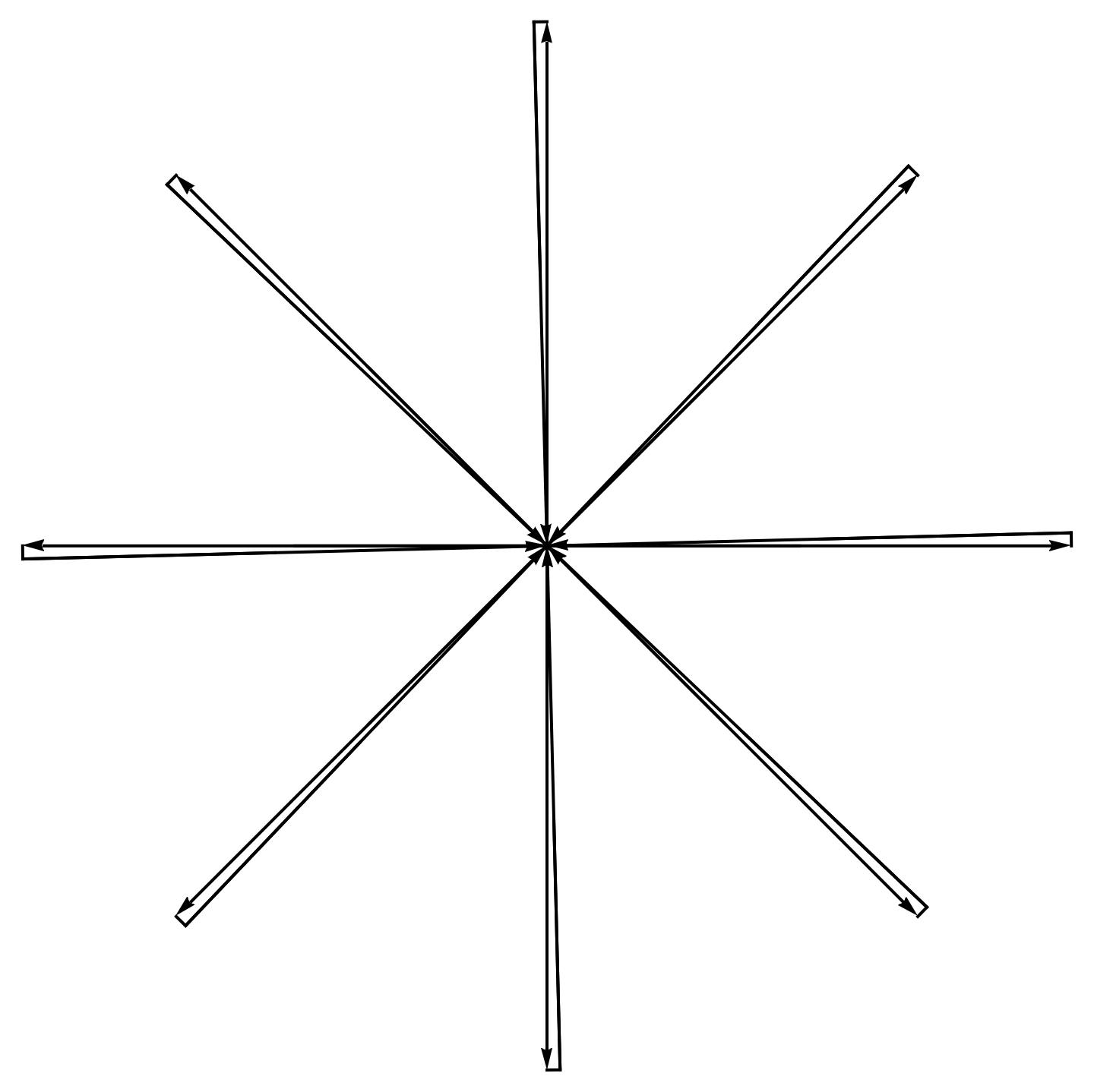Vorticity Statistics and Momentum Loop
The multiple area derivatives of \( \Psi \) yield the formula:
\[ \langle \exp(i\,\Gamma_C[v]) \, \omega(r_1)\otimes \omega(r_2)\otimes \dots \otimes \omega(r_n) \rangle_v = \frac{n!}{(2\pi)^n}\langle \exp(i\,\Gamma_{\tilde C}[P]) \int_{0<\theta_1<\dots<\theta_n<2\pi} d\theta_1\, \hat \omega(\theta_1) \otimes d\theta_2\, \hat \omega(\theta_2) \otimes \dots \otimes d\theta_n\, \hat \omega(\theta_n) \rangle_P; \tag{1} \]
\[ \hat \omega(\theta) \propto i\, \vec P(\theta) \times \Delta\vec P(\theta); \tag{2} \]
\[ \tilde C = \bigoplus_k L(r_C, r_k, r_C); \tag{3} \]
where \( L(r_C, r_k, r_C) \) is a double line from the center of mass, \( r_C = \frac{1}{n}\sum_{k=1}^n r_k \), to each point \( r_k \) and back to \( r_C \). The entire loop \( C \) resembles bicycle spokes without a wheel (see Fig. 1). The angles \( \theta_1, \dots, \theta_n \) are ordered on the unit circle.

These double lines cancel in the circulation,
\[ \Gamma_C[v]=0, \tag{4} \]
but not in the momentum loop representation. This occurs because, in the momentum loop integral,
\[ \int d\theta\, \vec C'(\theta)\cdot \vec P(\theta), \tag{5} \]
the momentum variable \( \vec P(\theta) \) depends explicitly on \( \theta \), preventing the cancellation of the two line integrals in a double line.
The factor \( \frac{n!}{(2\pi)^n} \) arises as follows. In the velocity representation, where the circulation is zero, the vorticities
\[ \vec\omega(\vec C(\theta_k)) = \vec \omega(\vec r_k) \tag{6} \]
depend directly on \( \vec r_k \) rather than on the angles \( \theta_k \). Consequently, the integral over ordered angles \( \theta_k \) yields the factor \( \frac{(2\pi)^n}{n!} \), which we must compensate with the inverse factor.
This leads to the fundamental formula for multiple vorticity correlation functions:
\[ \langle \omega(r_1)\otimes \omega(r_2)\otimes \dots \otimes \omega(r_n) \rangle_v = \frac{n!}{(2\pi)^n}\langle \exp(i\,\Gamma_{\tilde C}[P]) \int_{0<\theta_1<\dots<\theta_n<2\pi} d\theta_1\, \hat \omega(\theta_1) \otimes d\theta_2\, \hat \omega(\theta_2) \otimes \dots \otimes d\theta_n\, \hat \omega(\theta_n) \rangle_P; \tag{7} \]
\[ \Gamma_{\tilde C}[P] = \sum_{k=1}^n \int_0^1 d\eta\, (\vec r_k - \vec r_C)\cdot \vec Q_k(\eta); \tag{8} \]
\[ \vec Q_k(\eta) = \vec P(\tilde\theta_k(1-\eta)+\theta_k\eta) - \vec P(\tilde\theta_{k+1}\eta+\theta_k(1-\eta)); \tag{9} \]
\[ \tilde\theta_k = \frac{\theta_{k-1}+\theta_k}{2}\mod 2\pi. \tag{10} \]
This formula expresses the multiple correlation functions in terms of expectation values within the Euler ensemble. In [1], we use this approach to compute the two-point correlation function, \( \langle \omega \omega \rangle \), as a function of relative distance for \( n=2 \). The Fourier-space correlation function,
\[ \langle \vec \omega(k)\cdot\vec \omega(-k) \rangle, \tag{11} \]
(i.e., the energy spectrum), is found to be real and positive.
We conclude that the full statistical description of the rotational part of the velocity field (i.e., vorticity) is related to the statistics of the solutions \( \vec P(\theta,t) \) of the MLE.
A crucial aspect of this relation is the violation of time-reversal symmetry. Under time reversal, vorticity changes sign, which would typically eliminate vorticity correlations for an odd number of points (\( n \)). However, this is not the case in the momentum loop representation (7).
The distribution of the random variable \( \vec P(\theta,t) \) in general is not symmetric. In particular, the fixed trajectory for decaying turbulence we study below involves integration over rotation matrices \( \hat \Omega \in SO(3) \). These rotation matrices in three (or any odd) dimensions do not include reflections; therefore, only rotational symmetry is restored by this integration, but not the reflection symmetry \( \vec P \Rightarrow -\vec P \).
The absence of reflection symmetry in the momentum loop distribution results in explicit time-reversal symmetry violation, manifesting as nonzero odd-order vorticity correlations. Specifically, the triple correlation function (\( n=3 \)) is an odd function of the coordinates, similar to the K41 identity for the triple velocity correlation. However, as discussed in [1], the K41 relation applies only to the potential part of the velocity correlation and does not constrain the rotational part analyzed here.